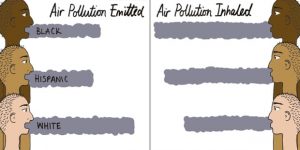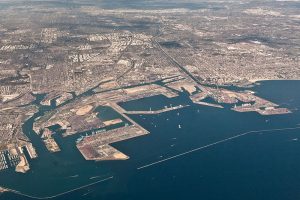(This is the third in our series of three articles on 2021 California legislation. The first is on whether 2021 will be the year California’s Legislature moves forward on transportation policies, and the second is on atmosphere-friendly California legislation in 2021.)
Environmental racism and air pollution in low-income communities and communities of color

California is a global climate and environmental leader. When Sacramento enacts a new law or regulation, it often goes beyond what other states or the federal government requires. Despite this, however, many places in California fail to meet national standards (known as “non-attainment areas”). Millions of Californians, particularly those who live in the Los Angeles-Inland Empire region and the San Joaquin Valley, breathe dirty air. This burden falls heaviest on low-income communities and communities of color, which are often located near pollution sources. As a result, these already vulnerable populations suffer from worse health, a reduced quality of life, and sadly – shorter lives.
Intentional decisions in the past, such as discriminatory redlining and racist land use policies have led to environmental injustice. Yet, failure to begin correcting these injustices and empowering communities only perpetuates it further. Even seemingly benign decisions can have unintended but real consequences for vulnerable communities. As such, it is important for policymakers to view environmental justice and equity as needing to be more than buzzwords. Fortunately, many of California’s leaders recognize this. It should be no surprise that most of these leaders also have experienced life in and currently represent environmental justice communities. Though correcting a century of environmental racism will take time and work, strong laws are an important first step.
The bills
AB 1296 by now-Senator Sydney Kamlager and SB 342 by Senator Lena Gonzalez would add environmental justice seats to the South Coast Air Quality Management District (SCAQMD) Governing Board. SCAQMD is responsible for the air quality in most of Los Angeles County, the urban parts of San Bernardino and Riverside counties and all of Orange County. Currently, most SCAQMD Governing Board members are local city council members and county supervisors. These bills would add two seats to the board for people who live and work in environmental justice communities. Half of California’s disadvantaged communities are within the South Coast Air Basin; yet, they have no direct voice at SCAQMD.
SB 499, by Senator Connie Leyva, would prohibit local governments from designating or expanding land uses that could potentially harm California’s most disadvantaged communities and neighborhoods. This bill will stop local governments from locating pollution sources in vulnerable communities. For example, many Inland Empire communities are seeing new warehouses placed near them. These warehouses attract trucks; bringing in toxic diesel exhaust, traffic, and other quality of life impacts. California is behind the curve when it comes to environmental justice as SB 499 is modeled on a landmark New Jersey law.

AB 1547, by Assembly Majority Leader Eloise Gómez Reyes, would require local governments and the California Air Resources Board (CARB) to do more to protect communities from unchecked warehouse growth. Further, AB 1547 would require CARB to develop rules to bring the state into compliance with federal air quality standards. To achieve this, the bill would empower CARB to develop a statewide rule to reduce warehouse pollution. This statewide warehouse pollution rule would complement, rather than supersede, local rules and regulations. Nearly 40% of all imports into the US go through the Ports of Los Angeles and Long Beach. From there, trucks then take most of these imports to warehouses scattered throughout Southern California. Goods movement corridors and warehouses are almost entirely located in disadvantaged communities.
AB 1001, by Assembly Member Cristina Garcia, would ensure communities and local governments are better informed on the negative impacts of local projects before approval. Additionally, AB 1001 would require all stationary pollution sources in non-attainment areas to install the best-available pollution controls. Current law only requires large polluters in non-attainment areas to install these controls. These smaller pollution sources have an outsized impact on the local community, especially in terms of toxic pollutants.








